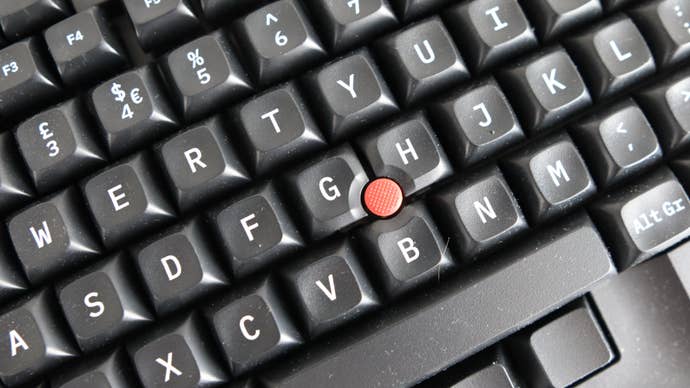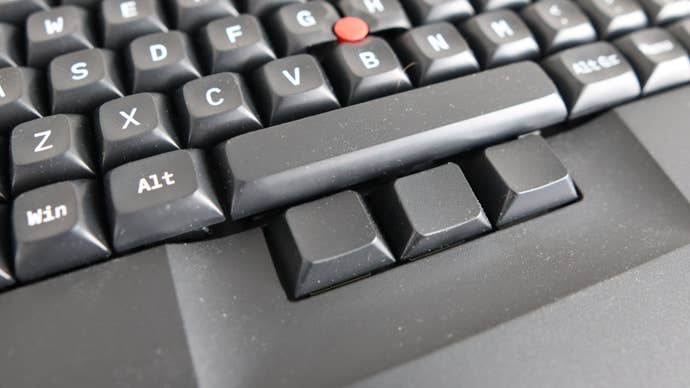The little red Trackpoint nubbin has been a fixture of ThinkPad-branded laptops since 1992, but I never knew until recently that both IBM and Lenovo made standalone mechanical keyboards with this extra input device too. Of course, those haven’t been made for a quarter of a century, but it’s actually still possible to find keyboards that sport it – and, in fact, surpass the original in terms of quality.
It was the expiry of the patent for the Trackpoint in 2017 that let the many-named “pointing stick” reappear in nicer mechanical keyboards – including the HHKB Studio that I tested last year.
The most promising examples though come from Tex, an obscure Taiwanese keyboard manufacturer founded to revive the classic ThinkPad-style keyboard in a fully-fledged mechanical style – and in multiple layout configurations to suit modern tastes, from compact 65 percent arrangements to the full seven-row madness. What I ended up testing is the Tex Shinobi, a curious keyboard that looks exactly like the bottom half of an old-school IBM laptop – but feels quite different.

The Shinobi is one of the brand’s first forays into this weird and wonderful world, and it’s based on the ThinkPad SK-8855 model from the late 2000s. It’s also one of the more ‘affordable’ options in the brand’s range, though it’s still nearly £200/$200. That’s a huge amount of money, but surprisingly less than the typical £250 asking price of an original SK-8855 in 2025.
On first impression, I was impressed with its look and feel. It’s a thick slab of plastic that has no flex or bend, as well as a pleasant slanted profile to aid typing comfort, while the taller and more sculpted black ABS keycaps with white legends aid its retro sensibilities. Plus, there’s the lovely red Trackpoint and three mouse buttons below the space bar. The chassis also extends out at the bottom to provide a comfortable, if unyielding, integrated wrist rest.
The layout here is the big talking point, bringing the full seven rows, meaning you get a proper function row, navigation keys, arrow keys and even basic media controls alongside the standard alphanumeric keys. Some keycaps are weirdly sized, such as the hilariously large Escape and Delete keys that span two rows in height. Nonetheless, as these extra keys are above and not to the side, it doesn’t encroach on your desk space much more than a 75 percent layout keyboard would. In fact, its length is virtually identical.
In actively using the Shinobi, I can see the logic behind its design. It gives even more functionality than you get on a TKL keyboard, especially with the handy additional media controls, as well as the convenience of the Trackpoint. Using it as an additional pointing stick can take some getting used to, but it works reasonably well with accurate tracking, while having mechanical mouse buttons is also a pleasant bonus. It is also available in ANSI or various ISO models (eg UK) to suit different regions – not always guaranteed with a lot of enthusiast models that are typically made only in small quantities.
The Shinobi is available either as a fully assembled model or as a DIY version with an associated build guide if you want to put your own switches inside. The fully-assembled version comes with an excellent variety of Cherry MX switches, with MX Red, Brown, Black and Blue choices, as well as rarer options such as MX Clear, Green, Silent Red, Speed Silver and the newer MX2A Ergo Clear models.
Mine came shipped with MX Browns, which have traditionally been my favourite MX switch with a lighter force and a reassuring tactile bump halfway down the keypress. I’ve used them for years, and in the Shinobi, they felt robust and generally lovely. Of course, they are a little scratchy first of all, but after using the keyboard for a few days from nine to five, they soon smooth out.


Connectivity is easy, with a USB-C cable that’s bundled in the box, and it worked happily with both Windows and macOS straight out of the box. There is some additional software in the form of a simple web-based configurator where you can remap keys, program macros and even save these changes as dedicated profiles if you so choose. It’s laid out well and gives the functionality that most folks are likely to use.
Do I recommend you actually go out and buy a Tex Shinobi for £191/$165? If you’re equally in love with that ThinkPad layout, then the Shinobi fits the bill perfectly and offers everything I could have wished for in an option from this niche market segment – a huge upgrade in typing feel, easy use with modern machines, yet that classic design. It’s a proper typist’s keyboard. However, most people won’t fall into these extremely tiny Venn diagram of “mechanical keyboard enthusiasts” and “ThinkPad aficionados”, and you could easily spend a fraction as much and get one of the many incredible mechanical keyboards available these days in a more standard form factor.
The Shinobi actually reminds me of the Filco Majestouch 3. Both of these thick slabs of plastic are visally products of their time, yet they remain functional, joyful typing machines. They’re a reminder of what the mechanical keyboard industry used to be, and a celebration of how these classic designs can stay relevant decades later.







